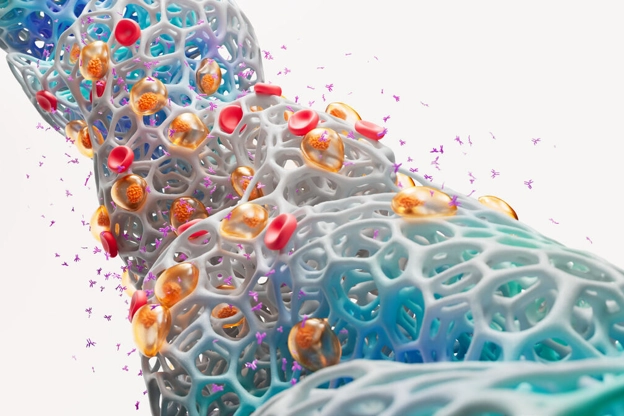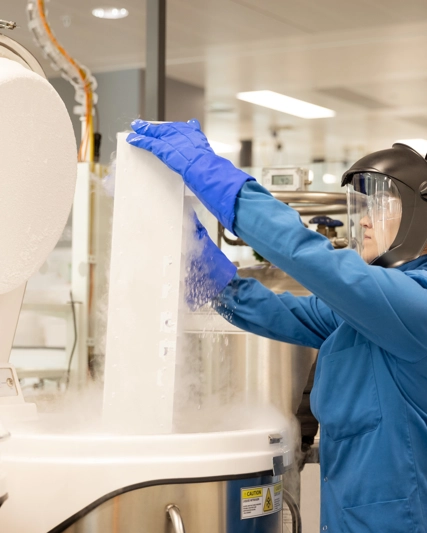Multiple myeloma
Multiple myeloma arises in a person’s bone marrow. It is the second most common blood cancer in the U.S., with an estimated 36,110 new cases to be diagnosed this year.

What is multiple myeloma?
- Multiple myeloma is the second most common blood cancer in the U.S., with an estimated 36,110 new cases to be diagnosed this year.1,2
- Multiple myeloma arises in a person’s bone marrow, when plasma cells mutate into problematic myeloma cells. These cells accumulate, crowding out healthy blood cells.3
What are the signs and symptoms of multiple myeloma?
While some may not exhibit symptoms of multiple myeloma, once myeloma cells begin to crowd normal blood cells, symptoms often appear. Some signs and symptoms of multiple myeloma include:3,4
- Breakdown of the bone resulting in high levels of calcium in the blood (hypercalcemia), which causes dehydration, excessive thirst, nausea, constipation and confusion
- Poor kidney function
- Anemia that may result in weakness dizziness and shortness of breath
- Weakened bones making patients more susceptible to fractures
- Weakened immune system causing more infections such as pneumonia
- Fatigue
Who can be impacted by multiple myeloma?
While everyone can be impacted by multiple myeloma, it is more common in:
- People who are at least 65 years old.5 The risk of developing multiple myeloma increases with age.
- Men3 are slightly more likely to develop multiple myeloma.
- African Americans8 are at twice the risk of developing multiple myeloma compared to white Americans.
How is multiple myeloma diagnosed?
- Multiple myeloma is often diagnosed through several exams and tests. Most commonly, doctors may run a variety of specialized blood and/or urine tests, bone marrow examinations, x-rays or other imaging tests and genetic tests.3
How is multiple myeloma treated?
There are various types of therapies a person’s doctor may choose to treat multiple myeloma or alleviate symptoms.6,7 Some of which include:
- Chemotherapy
- Corticosteroids
- Immunomodulators
- Proteasome inhibitors
- Monoclonal antibodies
- Nuclear export inhibitors6
- Stem cell transplants8
- Radiation9
- Surgery10
- CAR T-cell therapies11
- Intravenous immunoglobulin (IVIG)
- Blood transfusions
- Plasmapheresis7
References
Kazandjian D. Multiple myeloma epidemiology and survival: A unique malignancy. Semin Oncol. 2016;43(6):676–681. doi:10.1053/j.seminoncol.2016.11.004.
American Cancer Society Cancer Statistics Center. Myeloma. https://cancerstatisticscenter.cancer.org/#!/cancer-site/Myeloma. Accessed August 2025.
Gertz MA. Multiple Myeloma. NORD (National Organization for Rare Disorders). https://rarediseases.org/rare-diseases/multiple-myeloma/. Published 2016. Accessed August 2025.
Multiple myeloma. Genetic and Rare Diseases Information Center. https://rarediseases.info.nih.gov/diseases/7108/multiple-myeloma. Published 2016. Accessed August 2025.
American Cancer Society. Risk Factors for Multiple Myeloma. https://www.cancer.org/cancer/multiple-myeloma/causes-risks-prevention/risk-factors.html#references Accessed August 2025.
American Cancer Society. Drug Therapy for Multiple Myeloma. https://www.cancer.org/cancer/types/multiple-myeloma/treating/chemotherapy.html. Updated February 2024. Accessed August 2025.
American Cancer Society. Supportive Treatments for Patients with Multiple Myeloma. https://www.cancer.org/cancer/types/multiple-myeloma/treating/supportive.html. Updated February 2018. Accessed August 2025.
American Cancer Society. Stem Cell Transplant for Multiple Myeloma. https://www.cancer.org/cancer/types/multiple-myeloma/treating/stem-cell-transplant.html. Updated February 2018. Accessed August 2025.
American Cancer Society. Radiation Therapy for Multiple Myeloma. https://www.cancer.org/cancer/types/multiple-myeloma/treating/radiation.html. Updated February 2025. Accessed August 2025.
American Cancer Society. Surgery for Multiple Myeloma. https://www.cancer.org/cancer/types/multiple-myeloma/treating/surgery.html. Updated February 2024. Accessed August 2025.
American Cancer Society. CAR T-cell Therapy for Multiple Myeloma. https://www.cancer.org/cancer/types/multiple-myeloma/treating/car-t-cell-therapy.html. Updated February 2025. Accessed August 2025.


